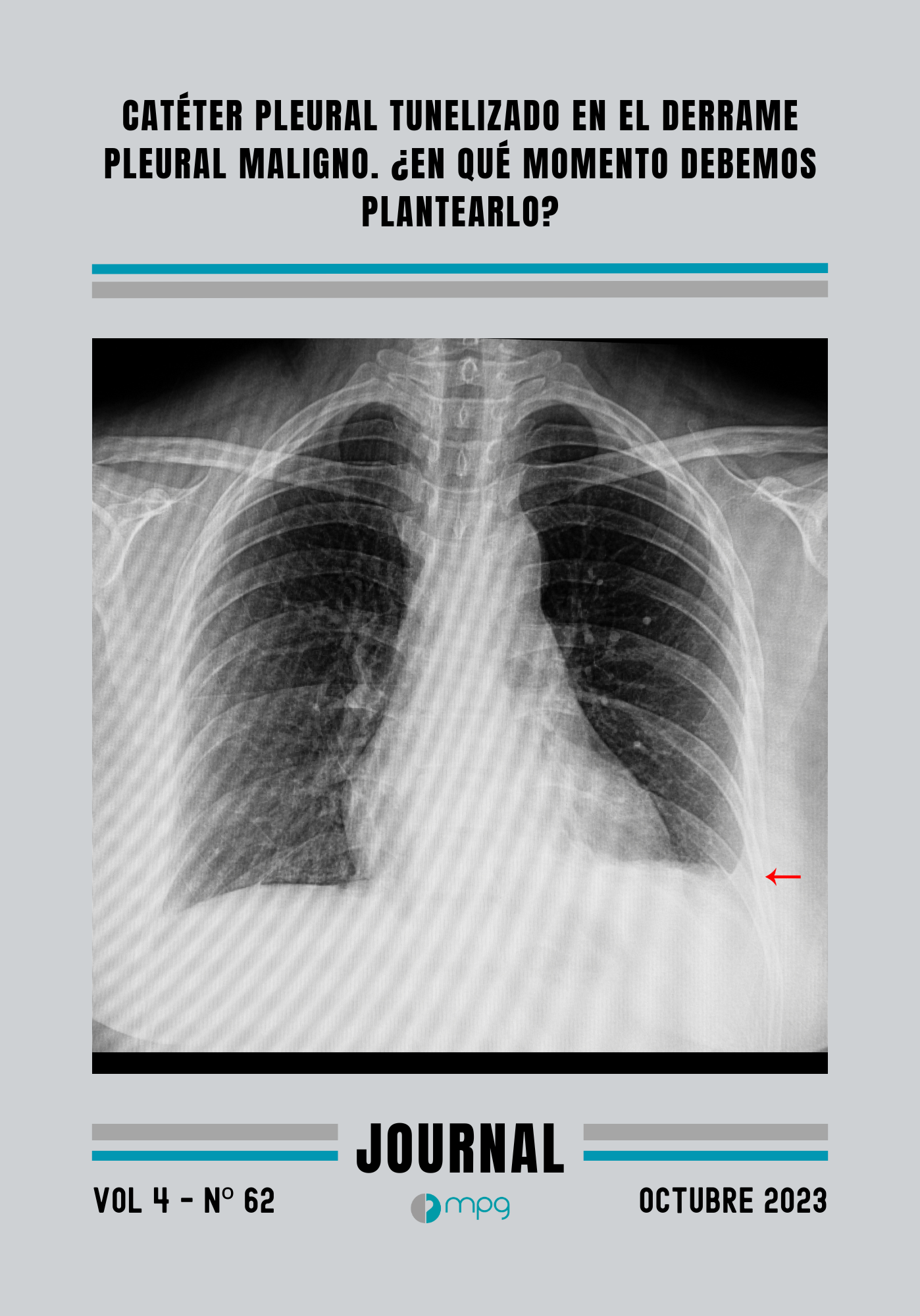12. Catéter pleural tunelizado en el derrame pleural maligno. ¿En qué momento debemos plantearlo?
Palabras clave:
Derrame pleural maligno, Catéter pleural tunelizadoResumen
El catéter pleural tunelizado es una alternativa al manejo tradicional del derrame pleural maligno, mejorando tanto la disnea como la calidad de vida. El objetivo del estudio fue valorar el momento ideal de su colocación en relación al tratamiento oncológico (previo, durante o al finalizar).
Se realizó una revisión sistemática de la evidencia disponible al respecto. Se incluyeron 10 estudios (2907 pacientes), mejorando la supervivencia sin mayor riesgo de complicaciones cuando se administró de forma concomitante al tratamiento oncológico.
El catéter pleural tunelizado es una opción del manejo del derrame pleural maligno, especialmente cuando se realiza de forma precoz, siendo una técnica segura.
Indwelling pleural catheter is an alternative to traditional management of malignant pleural effusion, improving both dyspnea and quality of life. The aim of the study was to determine the ideal timing of its placement in relation to systemic oncologic treatment (before, during or at the end of treatment).
A systematic review of the available evidence was performed. Ten studies (2907 patients) were included. The indwelling pleural catheter improved survival without increased risk of complications when administered concomitantly with oncological therapy.
The indwelling pleural catheter is an option in the management of malignant pleural effusion, especially when performed early, and is a safe technique.
Referencias
Feller-Kopman D, Light R. Pleural Disease. N Engl J Med. 2018 Feb 22;378(8):740-751. doi: 10.1056/NEJMra1403503. PMID: 29466146.
Mitchell MA, Burkett A, Li P, Zhang T, Amjadi K. Effect of chemotherapy on removal of indwelling pleural catheters in breast cancer patients with malignant pleural effusions. Respiration. 2018;96:552–9.
Hak CCW, Sivakumar P, Ahmed L. Safety of indwelling pleural catheter use in patients undergoing chemotherapy: a five-year retrospective evaluation. BMC Pulm Med. 2016;16:41.
Schwalk AJ, Ost DE, Saltijeral SN, De La Garza H, Casal RF, Jimenez CA, et al. Risk factors for and time to recurrence of symptomatic malignant pleural effusion in patients with metastatic non-small cell lung cancer with EGFR or ALK mutations. Chest. 2021;159:1256–64.
Akram MJ, Khalid U, Ashraf MB, Bakar MA, Butt FM, Khan F. Predicting the survival in patients with malignant pleural effusion undergoing indwelling pleural catheter insertion. Ann Thorac Med. 2020;15:223–9.
Thomas R, Fysh ETH, Smith NA, Lee P, Kwan BCH, Yap E, Horwood FC, Piccolo F, Lam DCL, Garske LA, Shrestha R, Kosky C, Read CA, Murray K, Lee YCG. Effect of an Indwelling Pleural Catheter vs Talc Pleurodesis on Hospitalization Days in Patients With Malignant Pleural Effusion: The AMPLE Randomized Clinical Trial. JAMA. 2017 Nov 21;318(19):1903-1912. doi: 10.1001/jama.2017.17426. PMID: 29164255; PMCID: PMC5820726.
Roberts ME, Rahman NM, Maskell NA, Bibby AC, Blyth KG, Corcoran JP, et al British Thoracic Society Guideline for pleural disease. Thorax. 2023 Jul;78(Suppl 3):s1-s42. doi: 10.1136/thorax-2022-219784.
Mitchell MA, Deschner E, Dhaliwal I, Robinson M, Li P, Kwok C et al Patient perspectives on the use of indwelling pleural catheters in malignant pleural effusions. Thorax. 2023 May 12:thorax-2022-219449. doi: 10.1136/thorax-2022-219449.
Ferreiro L, Suárez-Antelo J, Valdés L. Malignant Pleural Effusion Management. Arch Bronconeumol (Engl Ed). 2021 Jan;57(1):7-8. English, Spanish. doi: 10.1016/j.arbres.2020.05.037. Epub 2020 Jul 2. PMID: 32624211.
Muruganandan S, Azzopardi M, Fitzgerald DB, Shrestha R, Kwan BCH, Lam DCL et al Aggressive versus symptom-guided drainage of malignant pleural effusion via indwelling pleural catheters (AMPLE-2): an open-label randomised trial. Lancet Respir Med. 2018 Sep;6(9):671-680. doi: 10.1016/S2213-2600(18)30288-1. Epub 2018 Jul 20. PMID: 30037711.




MPG Journal - Política de privacidad